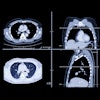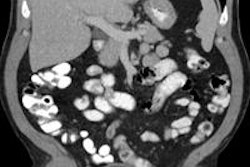A laxative-and-tagging regimen consisting of iodinated contrast plus a sodium phosphate mixture showed the best cleansing results among three concoctions in preparing for virtual colonoscopy exams. But a two-day regimen of iodinated contrast and a mild laxative at mealtime was better accepted by patients, according to a new study from Italy.
The multicenter study, led by Dr. Delia Campanella from the Institute for Cancer Research and Treatment in Candiolo, compared image quality at virtual colonoscopy (also known as CT colonography or CTC) in three different oral iodine-based preparation protocols. Iodine delivers better tagging consistency than barium, although higher doses can lead to diarrhea and other complaints.
"To date, there is no consensus on the best way to tag the bowel residue, the quantity and timing of contrast-medium administration, and whether and how strong laxatives are required to obtain a good quality tagging," they wrote, adding that most tagging-evaluation methods are too subjective.
The study compared cleansing effectiveness and patient acceptance among three regimens:
- GFPH: Sodium phosphate and iodine, consisting of a diluted solution of 100 mL sodium diatrizoate and meglumine diatrizoate, with an iodine concentration of 370 mg/mL and total iodine load of 37 g (Gastrografin, Bracco, Milan, Italy) in 1.5 L water. Subjects drank 250 mL at three meals daily beginning two days before VC, with the last dose two hours prior to imaging. One day before scanning, patients drank two vials (one every 10 hours) of 45 mL sodium phosphate (Phospho-soda, Fleet, Lynchburg, VA).
- SD: Mild purgation with same-day fecal tagging. Participants ingested a sachet of Macrogol 3350-based mild laxative (Movicol, Norgine Italy, Milan) at three meals daily beginning two days before VC. Two hours before scanning, they ingested a 50-mL dose of sodium diatrizoate and meglumine diatrizoate solution diluted in 500 mL of water (total iodine load, 18.5 g). To avoid artifacts caused by the high concentration of the residual contrast material in the gastric lumen, patients were also asked to drink an additional 500 mL of water.
- GF: No laxatives were used; iodine formula was based on the participant's body weight by diluting 2 mL/kg of sodium diatrizoate and meglumine diatrizoate in 2 L water, to a maximum 150 mL (maximum total iodine load, 55.5 g). Approximately 330 mL doses were ingested at three meals beginning two days before VC.
Sixty randomly selected individuals undergoing CTC screening for average or elevated colorectal cancer risk were included in each of the three groups.
Images were acquired supine and prone on a 16-detector-row CT system (LightSpeed 16, GE Healthcare, Chalfont St. Giles, U.K.) set at 120 kVp, effective mAs of 50 or less, section thickness of 2.5 mm or less, and a reconstruction interval of 1.25 mm. Computer-aided detection (CAD) software (im3D, Turin, Italy) counted false-positive prompts for each patient.
Two independent, experienced radiologists graded tagging quality; quantitative measures included the tagged stool density and CAD false-positive rate.
The GFPH and SD regimens delivered better subjective prep quality compared to GF (p < 0.001), which yielded more poorly tagged segments. For GF, the measured average stool density was less than 200 HU in 10.7% of all segments, compared to 3.6% for SD and less than 0.5% for GFPH.
The ascending colon and the cecum were poorly tagged most frequently. The CAD false-positive rate increased following the trend: GFPH had fewer false positives than SD, which had fewer false positives than GF (p = 0.00012), Campanella and colleagues reported.
However, GFPH was less accepted by patients, who rated their discomfort on an 11-point scale, where 0 corresponded to no discomfort and 10 to extreme discomfort.
Patient acceptance varied between all three regimens (p = 0.0043). A by-pairs comparison showed that GFPH was less tolerated than the SD regimen (p < 0.05), which conferred several advantages over other regimens.
With SD, the iodine solution was given in a protected environment, "making it possible to deal promptly with any severe adverse reactions, though we have never experienced them," the authors wrote. In addition, the 18.5 g iodine load with this regimen is small, and the Macrogol-based mild laxative is well tolerated.
"GFPH provided a homogeneous pattern of fecal tagging, with a total administered volume of iodine smaller than other protocols, but it rated as the worst accepted among the three regimens which we have evaluated," they noted, a finding they said might be attributable to the presence of a strong laxative.
GFPH was the best regimen in terms of prep quality, but SD offered the best balance between bowel preparation quality and patient acceptability, the group concluded.
By Eric Barnes
AuntMinnie.com staff writer
September 21, 2009
Related Reading
Sophisticated electronic bowel cleansing boosts polyp detection, August 3, 2009
Minimal prep VC nearly as sensitive, better tolerated, March 7, 2009
Image tools cut false positives in unprepped VC, August 4, 2008
VC CAD finds polyps in prepped or unprepped patients, May 6, 2008
CAD beats human readers in multicenter trial data, November 19, 2007
Copyright © 2009 AuntMinnie.com




















